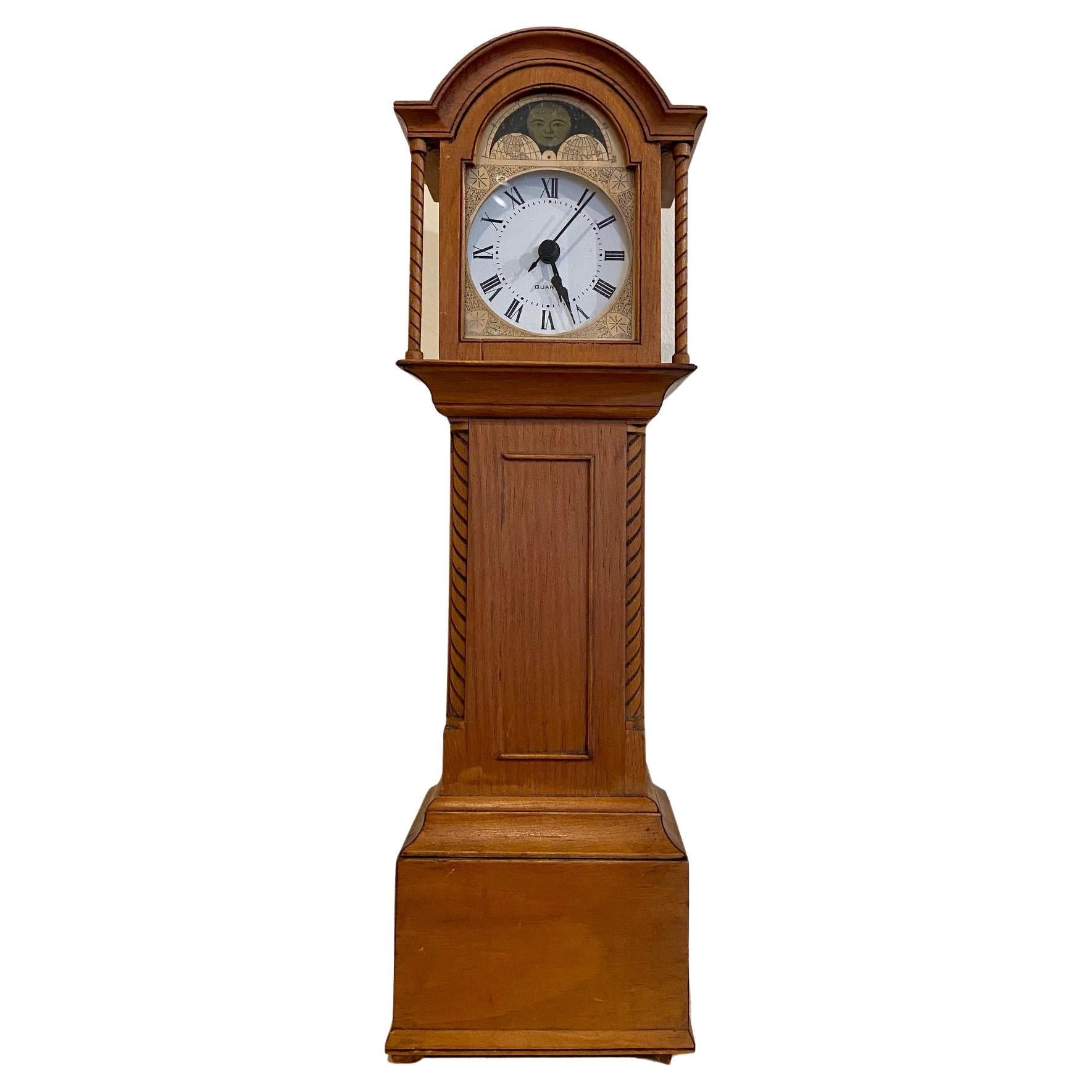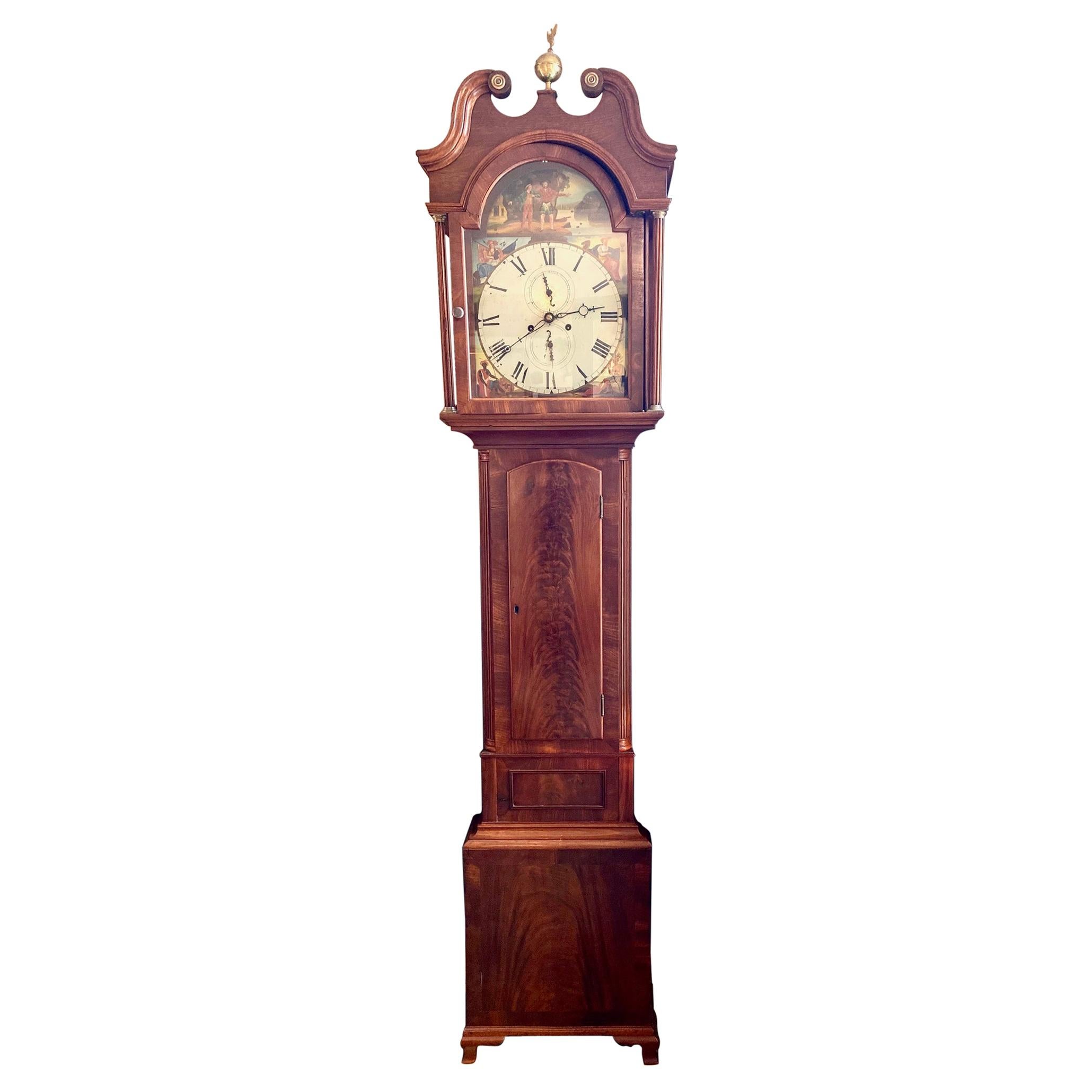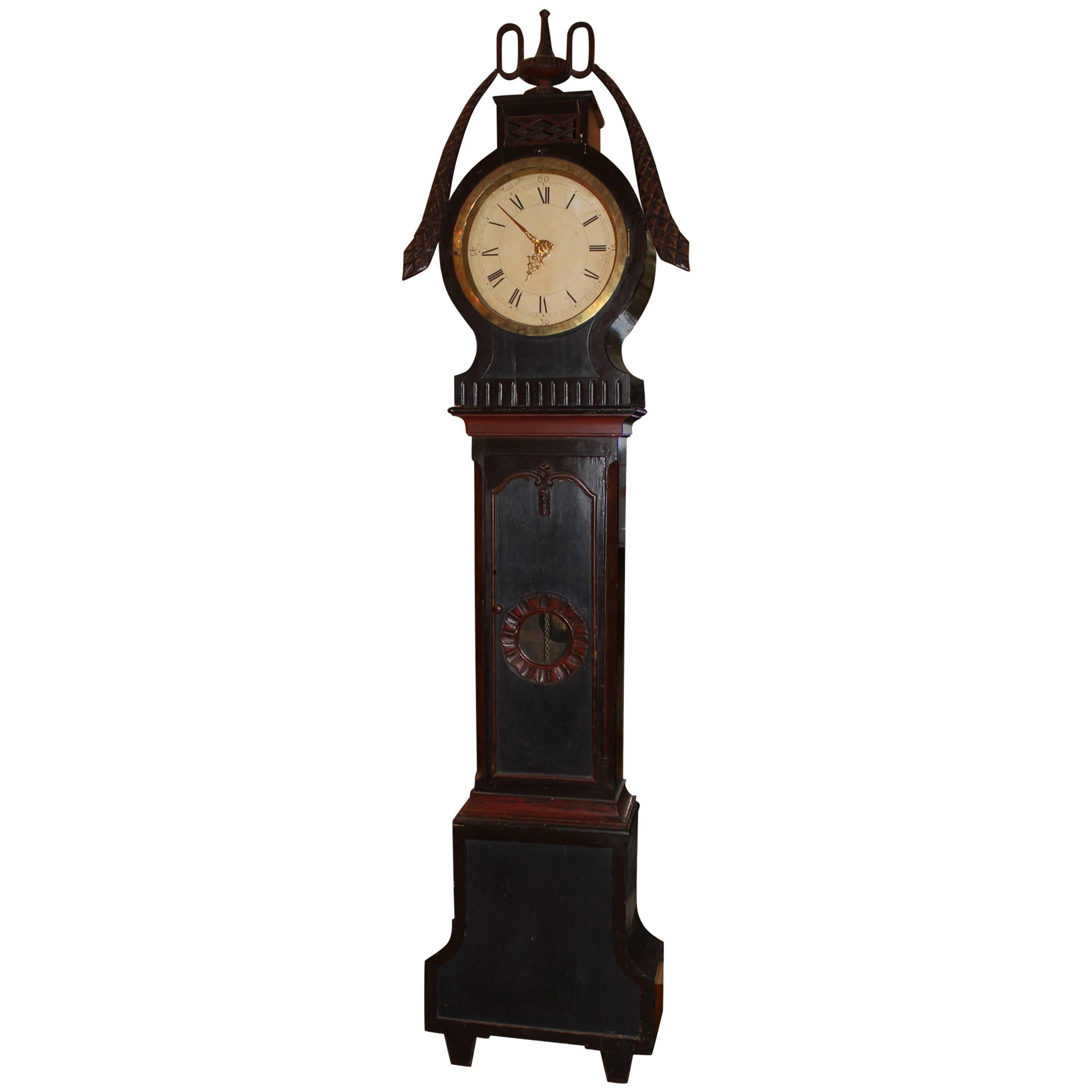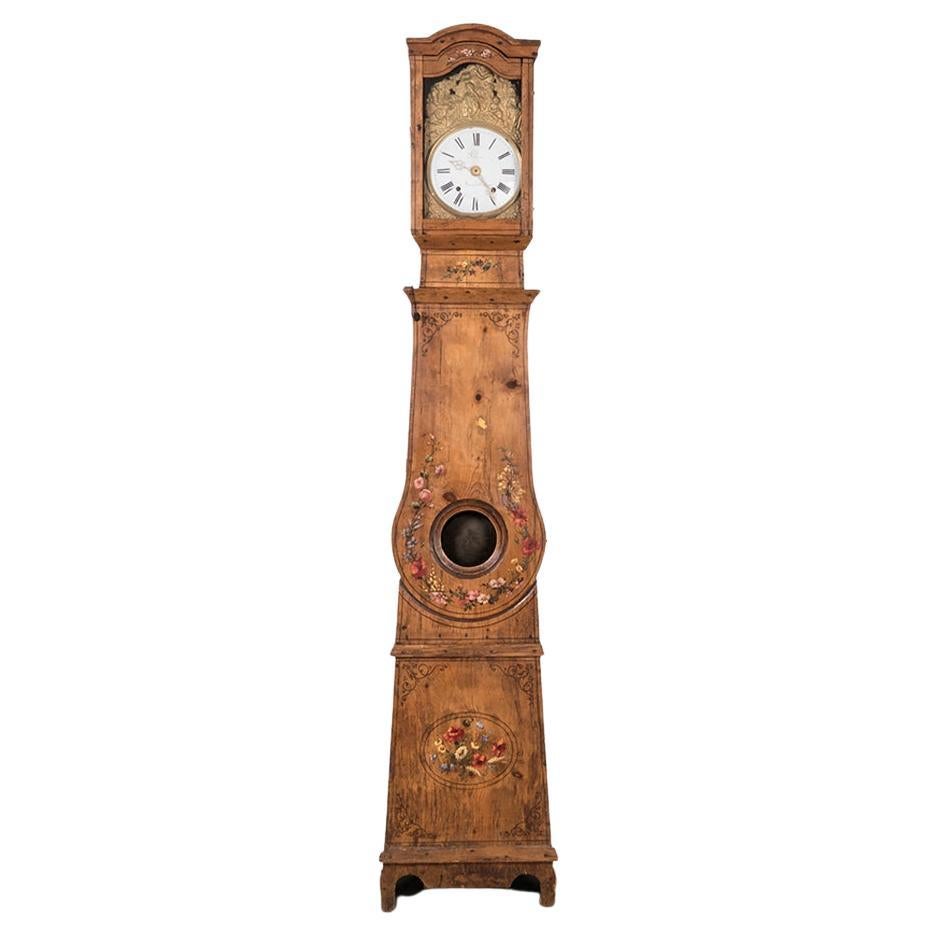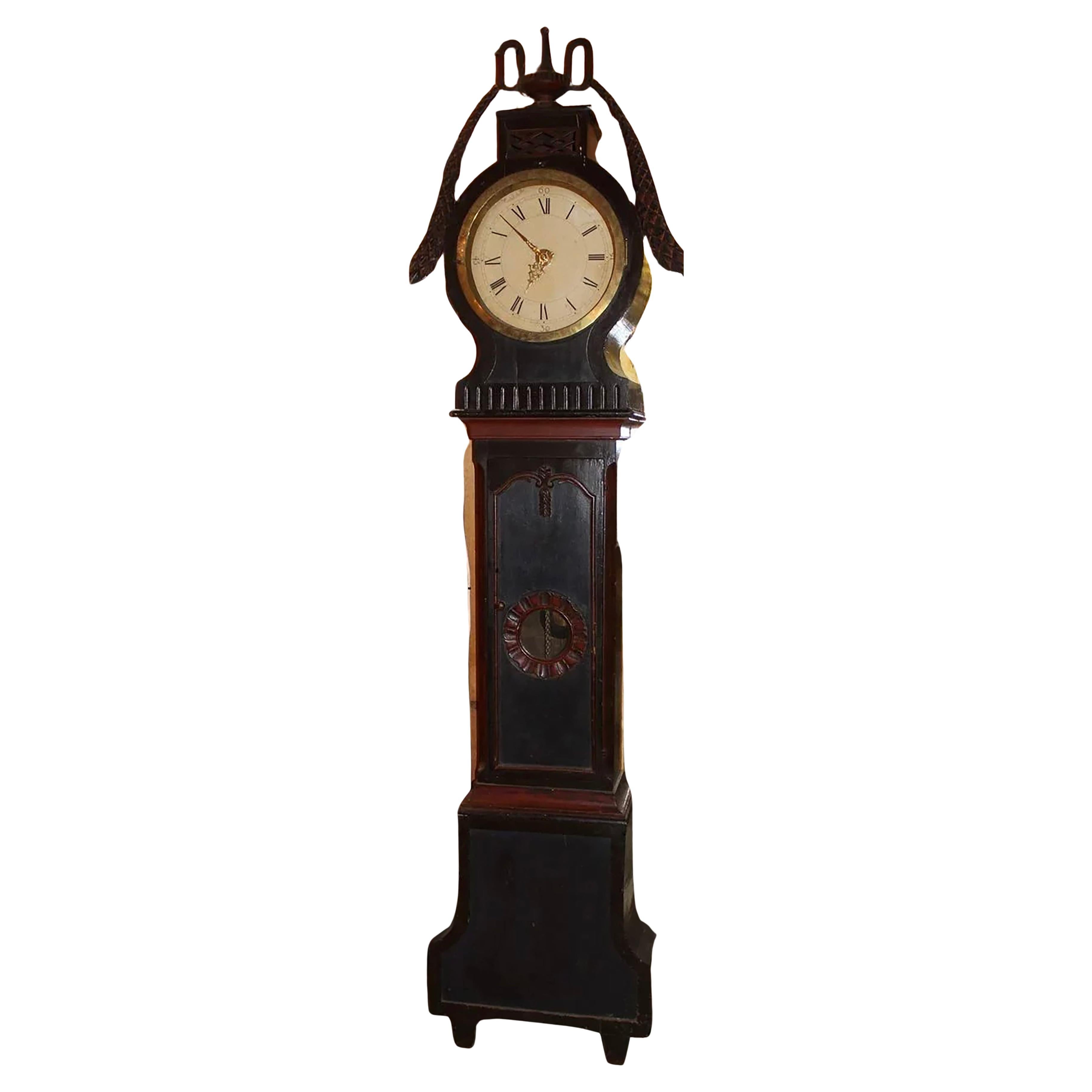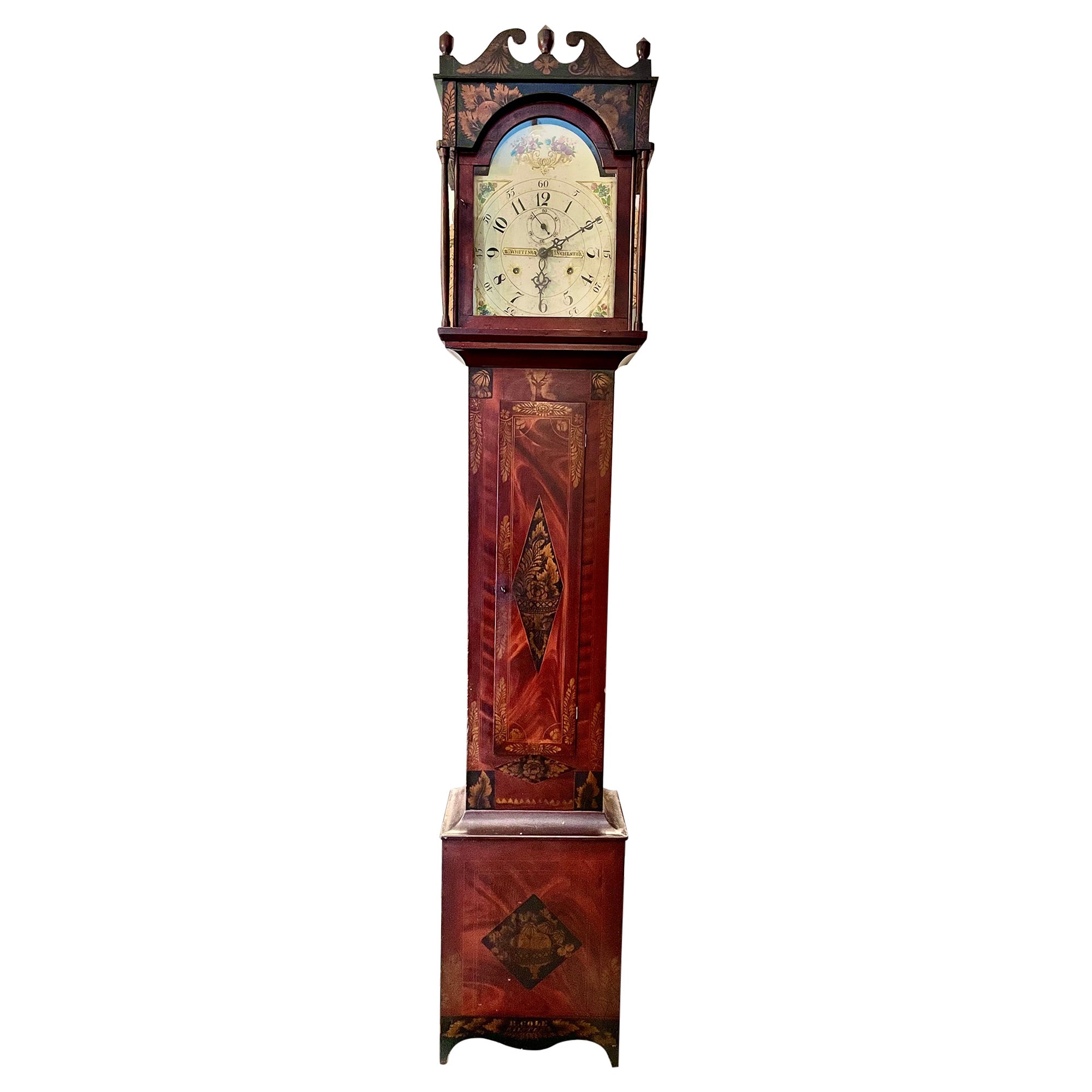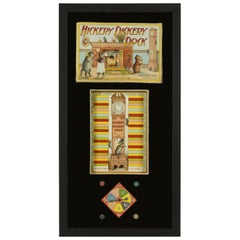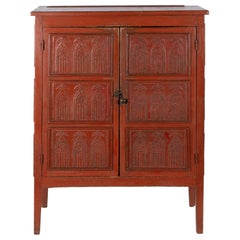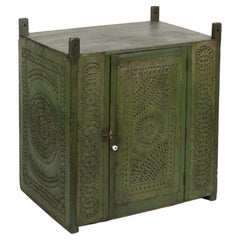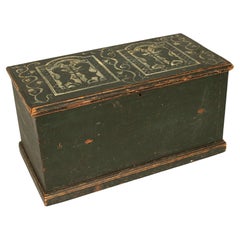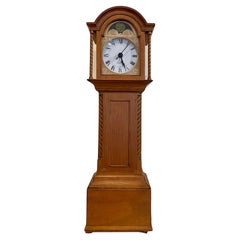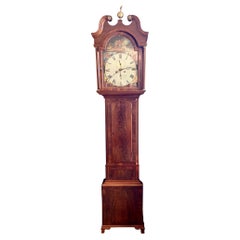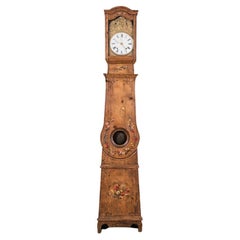Items Similar to New England Tall Case Clock, Wooden Works by Riley Whiting, ca 1819-1835
Want more images or videos?
Request additional images or videos from the seller
1 of 18
New England Tall Case Clock, Wooden Works by Riley Whiting, ca 1819-1835
$23,500
£17,831.26
€20,388.45
CA$32,823.13
A$36,494.85
CHF 19,055.60
MX$444,231.22
NOK 243,141.13
SEK 227,811.62
DKK 152,162.76
Shipping
Retrieving quote...The 1stDibs Promise:
Authenticity Guarantee,
Money-Back Guarantee,
24-Hour Cancellation
About the Item
Exuberantly painted, New England tall case clock in dark umber, red, & chrome yellow decoration, with wooden works by riley whiting, Plymouth, Connecticut, ca 1819-1835
This wonderful tall case clock is one of a known and very special group of New England examples. Most of those identified, and this one in particular, have wooden works by Riley Whiting of Connecticut. The exuberantly paint-decorated cases have been attributed by some to Vermont and, in at least one case, more specifically, to the Matteson family of cabinetmakers who worked within that state.
The form is traditional for an American clock of the early 19th century, with a broken arch pediment, columns on either side of a tombstone-shaped face, concave moldings stepping down to a narrower case and then back out to the base, where there is a scalloped skirt, scrolling out to fine Hepplewhite feet.
The base color is dark umber, upon which are fanciful, rectangular, grain-painted designs, in strong, orangish-red and brown, made to look like inset panels. These are included on all three visible sides of the base and hood, as well as on the long, central case and door. The crown is likewise decorated, as-is the perimeter of the glass. The crown, columns, and the stiles that flank each side of the door, are punctuated with chrome yellow bands, squares, rosettes, and the like, and the finials are decorated in yellow and red. This particular design, with doors on both sides of the hood, is especially unusual among painted clocks.
The face features an oval landscape with a house and trees. Smoke rolls out the chimney and there is another home or outbuilding to one side. There are shell designs in each corner with yellow and green trimmings, surrounding the dial, which has both a second counter and calendar. This is a 30-hour works that strikes a bell on the hour.
Riley Whiting (1785-1835) was the most famous of the New England wooden works clock-makers. He apprenticed with his inlaws, the Hoadleys in Plymouth, Connecticut. In 1803, Whiting’s future brother-in-laws, Samuel and Luther Hoadley, moved to the town of Winchester. In 1806, at age 21, he married their sister, Urania. In 1807, the three men formed a partnership and began building both short and long pendulum clocks. Because both Whiting and the Hoadleys were Masons, many Whiting clocks were marketed to the Masonic community and had faces painted with Masonic symbols.
Both Hoadleys enlisted in the United States Army for service in the War of 1812. Luther died in 1813 at Groton, CT. At this time, the business was operating under the name Hoadley & Whiting. During this time he is widely thought to have perfected the eight-day, wooden-geared movement. In 1819, Samuel, who survived the war, sold his remaining share in the business to Whiting, who continued as a sole proprietor until he passed in 1835. In 1841, Urania sold what remained to Gilbert Clock Company of Winstead, Connecticut.
Sometimes Whiting may have made and painted his own cases, but almost universally they were sold both to individuals and to cabinetmakers, who were expected to make their own. Many were sold door-to-door by itinerant salesmen. In these instances, cases were probably seldom made and the buyers simply used them as wag-on-the-wall clocks.
When Riley Whiting’s works actually went into cases, they were almost universally of the paint-decorated variety as opposed to fine woods. It is of interest to note that a cousin, Silas Hoadley--who worked with famous clock-makers Eli Terry and Seth Thomas at roughly the same time in Plymouth—bears perhaps the next most recognizable name that appears on the faces of paint-decorated, tall case clocks encountered today.
I briefly owned another clock by this same decorator about 20 years ago. Another, which belonged to my good friend Helaine Fendleman, sold at Sothebys in 1993 and was featured on the cover of the catalogue. Another is among the holdings of the Henry Ford Museum in Dearborn, Michigan. The latter two examples are illustrated in “The American Clock: A Comprehensive Pictorial Survey, 1723-1900,” by Distin and Bishop (1976, E.P. Dutton & Co., New York), p. 55. The Fendleman example is also illustrated in “American Painted Furniture” by Scaffner and Klein (Clarkson N. Potter, Inc., New York), p. 105.
All-in-all, a notably colorful and great surviving examples across known paint-decorated American tall clocks. Provanance: Ex-Guy Bush.
Condition: The works were re-strung, and some gear-related woodwork was needed. The pendulum and weights are not original, but the clock has been professionally tuned up and keeps good time, especially for a 200-year old wooden works. The panels on the arched pediment were at one time re-painted and very poorly done. I personally re-painted them, following the basic flow of what I determined to be the original decoration and keeping with the theme. There was some previous retouch in the yellow adornments. The finials may be original but are heavily retouched at the very least or are repainted if they are. These are removable as-is typical. There are minor to modest losses elsewhere in the decoration and minor to moderate losses on the moldings. I applied a light varnish to hydrate, stabilize, and seal. The paint is 90% original. The extremely high quality of the color and form among early, painted, American tall clocks well-warrants the state of preservation. There isn’t much that survives in this class.
- Dimensions:Height: 89.5 in (227.33 cm)Width: 17.25 in (43.82 cm)Depth: 9.75 in (24.77 cm)
- Materials and Techniques:
- Place of Origin:
- Period:
- Date of Manufacture:1819-1835
- Condition:See Item Description.
- Seller Location:York County, PA
- Reference Number:Seller: clk-0101stDibs: LU849728646092
About the Seller
5.0
Recognized Seller
These prestigious sellers are industry leaders and represent the highest echelon for item quality and design.
Established in 1991
1stDibs seller since 2008
70 sales on 1stDibs
Typical response time: 1 to 2 days
- ShippingRetrieving quote...Shipping from: York County, PA
- Return Policy
Authenticity Guarantee
In the unlikely event there’s an issue with an item’s authenticity, contact us within 1 year for a full refund. DetailsMoney-Back Guarantee
If your item is not as described, is damaged in transit, or does not arrive, contact us within 7 days for a full refund. Details24-Hour Cancellation
You have a 24-hour grace period in which to reconsider your purchase, with no questions asked.Vetted Professional Sellers
Our world-class sellers must adhere to strict standards for service and quality, maintaining the integrity of our listings.Price-Match Guarantee
If you find that a seller listed the same item for a lower price elsewhere, we’ll match it.Trusted Global Delivery
Our best-in-class carrier network provides specialized shipping options worldwide, including custom delivery.More From This Seller
View AllHickory Dickery Dock Early Parker Brother Board Game
Located in York County, PA
Hickory Dickery Dock: Early Parker Brothers board game with great cat & mouse and tall case clock graphics, 1900.
Patented in 1899 and produced in 1900, this colorful Parker Brother...
Category
Antique Late 19th Century North American Game Boards
Materials
Paper
Unusual Form Pie Safe with Lantern Style Tins
Located in York County, PA
Unusual form pie safe with lantern-style tins and striking, tomato red paint, circa 1840
Of all the pie safes that I have owned in thirty years of buy...
Category
Antique 1840s American Painted Furniture
Materials
Wood
Green Painted Pennsylvania Hanging Pie Safe, ca 1850-1880
Located in York County, PA
Pennsylvania hanging pie safe, in first surface green paint, with circular medallion and opposing fan decoration, circa 1850-1880
Pennsylvania hang...
Category
Antique Mid-19th Century American Painted Furniture
Materials
Wood
Mahantango Valley Pennsylvania Blanket Chest with Unicorns, ca 1820-1840
Located in York County, PA
Diminutive blanket box, in windsor green paint, with rare and beautiful unicorn stencils. Made ca 1820-1840, the chest was found in the Mahantango Valley of Pennsylvania. Very likely...
Category
Antique Early 19th Century American Painted Furniture
Materials
Wood
"The Graduate" Masterpiece Tramp Art Carving
Located in York County, PA
Masterpiece tramp art carving: "THE GRADUATE"
This exceptional tramp art figure and podium, nicknamed "The Graduate", is one of the best pieces of this genre of work that I have ever seen. If the form is outstanding, the painted surface is better, scoring a firm ten out of ten.
Probably of Pennsylvania origin, the carving was sold about 25 years ago by Lehigh Valley...
Category
Antique Late 19th Century American Sculptures and Carvings
Materials
Wood
34 Star Antique American Flag with Hourglass Medallion Stars, ca 1861-1863
Located in York County, PA
EXTRAORDINARY 34 STAR ANTIQUE AMERICAN FLAG WITH AN ACCORDION OR HOURGLASS MEDALLION CONFIGURATION THAT SURROUNDS A PENTAGON OF STARS IN THE CENTER; MADE OF FINE SILK AND ENTIRELY HAND-SEWN; MADE DURING THE OPENING YEARS OF THE CIVIL WAR (1861-63), IN A TINY SIZE AMONG ITS COUNTERPARTS OF THE PERIOD; REFLECTS THE ADDITION OF KANSAS AS THE 34TH STATE
34 star flag of the Civil War period with an array of rare, beautiful, and otherwise desirable features. Extremely small among flags of this period with pieced and sewn construction, the flag displays a star pattern that is not only highly unusual, but unique to this particular example. This consists of a single star in the very center, surrounded by a pentagon of stars, flanked by angular bracket of three stars to either side. Above and below are rows of 5 stars, followed by rows of 6 that line the top and bottom of the canton. The resulting configuration is what I have termed an “accordion medallion,” though “hourglass medallion” or “standing bow tie” would be perfectly acceptable.
When rotated 90 degrees, to view the harder-to-identify, bow tie formation, students of early star patterns may note the visual similarity between this and what I call “Starburst” or “Crosshatch” medallions. The pattern, however, conspicuously lacks the crosses of St. Andrew (a saltire) and St. George (roman cross), that would allow it to be more accurately categorized as such.
Entirely hand-sewn, the canton and stripes of the flag are made of fine silk. The hemming of this was accomplished with great skill. The top and bottom edges are selvedge. These are so similar in nature as to have come from the same maker. There is a white, silk binding along the hoist, in the form of an open sleeve, through which a length of braided hemp rope was passed, expertly looped and re-braided into itself at the top and bottom for strength.
The stars are made of white, polished cotton. These were stitched to both sides (double-appliqued). Note how the edges of the fabric were not turned under, providing evidence of the fact that the maker was not especially skilled in appliqueing. This was common, as applique work was far more difficult than producing French seams.
In the 19th century, most flags with pieced and sewn construction were 8 feet long and larger. A six-footer was considered small. Even military battle flags, carried on foot, measured 6’ x 6.5’, which translates into approximately 7’ x 7.5’ after framing, about the size of an average quilt and larger than can comfortably fit on a wall in a house with 8-foot ceilings and average width baseboard. Flags smaller than this were produced both commercially and at home, but the smaller they are, the more unusual they are. At just 26.5 x 46.5 inches, this flag is extremely small for a Civil war period flag with sewn construction.
Silk was both beautiful and lightweight, which made it elegant for military unit colors and preferable for flags meant to be carried on foot. Most outdoor use flags...
Category
Antique 1860s American Political and Patriotic Memorabilia
Materials
Silk
You May Also Like
Nantucket Miniature Long Case Clock, circa 1894
Located in Nantucket, MA
Rare Antique Nantucket miniature long case clock, made and patented by Wallace Brown, circa 1894, with original paper label and poem. A Hand crafted mahogany case with arched bonnet,...
Category
Antique 1890s American Folk Art More Folk Art
Materials
Mahogany
Early 19th Century Tall Case Clock by James Hogg, circa 1820
Located in Nantucket, MA
Early 19th century tall case clock by James Hogg, from village of Gifford near Edinborough, circa 1820, with fine mahogany case, brass fin...
Category
Antique 1820s Scottish Regency Grandfather Clocks and Longcase Clocks
Materials
Mahogany
19th Century Swedish Tall Case Clock with Painted Case
Located in Milford, NH
Wonderful polychrome 19th century Swedish tall case clock with central urn with swags, Roman numeral dial, brass works and waist door with ci...
Category
Antique 19th Century Swedish Grandfather Clocks and Longcase Clocks
Antique French Provincial Tall Case Clock In a Painted Case, ca. 1870
Located in AMSTERDAM, NH
Very decorative and charming French tall case clock featuring a painted pine case adorned with floral decorations.
The porcelain clock dial bears the si...
Category
Antique Late 19th Century French Country Grandfather Clocks and Longcase...
Materials
Metal, Brass
19th Century Swedish Tall Case Clock with Painted Case
Located in Milford, NH
Wonderful polychrome 19th century Swedish tall case clock with central urn with swags, Roman numeral dial, brass works and waist door with circular window. Very good overall conditio...
Category
Antique 19th Century Swedish Grandfather Clocks and Longcase Clocks
Materials
Brass
American Federal Grain Painted and Stenciled Tall Clock by Rufus Cole
Located in Essex, MA
A Rare and Complete American Federal Tall Case Clock. Riley Whiting Wooden Works, original. A Rufus Cole Grain-Painted and Stenciled Case. S...
Category
Antique Early 19th Century American Federal Grandfather Clocks and Longc...
Materials
Pine
More Ways To Browse
Antique Red Painted Furniture
Antique Brown Paint Color
Back Painted Glass
Antique Wood Panel Painted
Grain Painted
Grain Painted Furniture
Antique Red Paint Color
Antique Green Paint Color
Antique Yellow Paint Color
Early American New England Furniture
Folk Art Wood Panel
Wooden Crown
Tall Narrow Art
Wooden Bell
New England Folk Art
Concave Glass Art
Bells Made In England
Bear Clock
